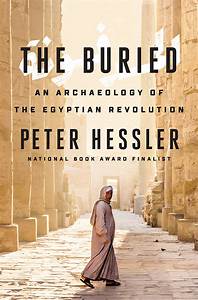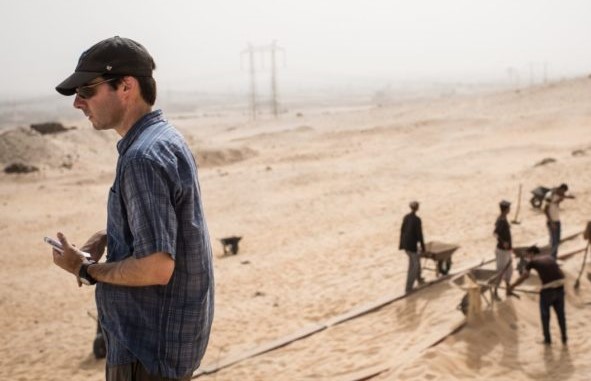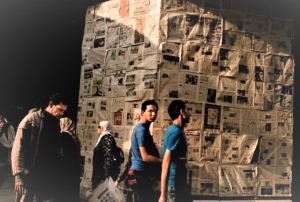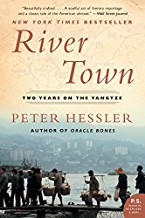Review — THE BURIED by Peter Hessler (China)
 The Buried: An Archaeology of the Egyptian Revolution
The Buried: An Archaeology of the Egyptian Revolution
By Peter Hessler (China 1996–98)
Penguin Press
480 pages
May 2019
$28,00 (hardback); $14.99 (Kindle)
Reviewed by Andy Martin (Ethiopia 1965–68)
•
I’ve been racking my brain as to how to best review this wonderful book. Perhaps I just did by calling it wonderful. Peter Hessler is a well-established writer and has had a number of fascinating and important books and articles published. He was also a staff writer for The New Yorker. In fact, The Buried, grew out of an assignment he had, to cover the Egyptian Revolution during the “Arab Spring” in the early 2010’s. The Buried was published in May of 2019. I’m writing thus review in late July 2019, only a few months later. However, the book has already had a number of major reviews, including one on this Peace Corps writer’s website. It was also reviewed a couple of weeks ago in the New York Time Book Review, by an Egyptian reacting as a native Egyptian to a non-Egyptian writing about a subject very close to her experience. This seems to be the essence of Peter Hessler’s books and articles. He lives what he writes. He’s also written extensively about his time living in China, as a non-Chinese. Apparently, Hessler believes in immersing himself and his family in whatever country he writes about. He’s no tourist. He was a Peace Corps volunteer in China and stayed on after his contract was over. In 2011 he moved himself and his family to Egypt. In China he learned Chinese. In Egypt he learned Arabic. This guy has a real Peace Corps ethos in learning and writing about a country and its culture.
It is this ethos that most drew me to The Buried. In the summer of 1966, having just finished my first year as a Peace Corps Volunteer in Harar, Ethiopia, I was thinking about how to spend my one month of summer vacation. Most of the other PCV’s who were teachers, went south, many to Kenya and Tanzania. A PCV friend and I decided on another route. We wanted to travel “down” the Nile River to Egypt. The Nile, or one of its main branches, specifically the Blue Nile, originates in the highlands of northwest Ethiopia, flowing North to Khartoum, where it merges with the White Nile and then heads down to Alexandria, in Egypt, emptying into the Mediterranean Sea. Counterintuitively, the Nile flows north, so “down” is really “up.” Hessler stresses this in his book, explaining that Upper Egypt is in the south while Lower Egypt is in the North.
To paraphrase Peter Hessler, the Nile is Egypt and Egypt is the Nile. I had my own encounter with the Nile at Luxor. We spent a blisteringly hot day riding donkeys as we toured the tombs, including that of Tutankhamen. Luxor is on one side of the Nile and The Valley of the Kings was on the other. By late afternoon, we were totally sunburned and exhausted as we arrived back at the Nile. We had hooked up with a bunch of young people our age (early 20’s), and most of them took the ferry back to Luxor. Three of us did not – two British guys who had been on their school swim teams and I. We were so hot, we really wanted to take a dip in the Nile and they suggested swiming across it, back to Luxor. I said “sure, why not?” (I was never on a swim team). Long story short – they made it across in about 20 minutes; I, on the other hand did not consider the river’s current which carried me downstream faster than I could swim across. I wasn’t going to make it but didn’t realize it. Lucky for me, a ferry came by and they pulled my out of the water, just as my legs were beginning to cramp. I had probably been mere minutes away from drowning. I later learned that the Nile is one of the most heavily infested rivers in the world with Schistosome worms and had to be tested for Schistosomiasis (it was negative). That was the hairiest part of my Egyptian trip. We continued by train from Luxor to Cairo and finally, Alexandria, setting of the Alexandria Quartet, by Lawrence Durrell, which we were all reading that summer, having received one fourth of the quartet in our Peace Corps Book Lockers. Ironically Durrell was another non-Egyptian writing about Egyptian life.
In describing Southern Egypt where most of the archaeological digs are, Hessler makes a big point of describing Egyptians’ relationship to its treasures being dug up and taken away to museums around the world. How those organizing and participating in the digs pretty much ignored the Arab Spring and the Egyptian revolution. Many of the early archaeologists never even bothered to learn Arabic. Egyptians themselves seem to relate to the tombs and artifacts more as sources of tourist income and source of stuff to raid. In fact, the tombs have been raided for centuries. The field of “Egyptology” is mostly a western science that doesn’t concern itself with modern day Egypt or Egyptians for that matter.
“The Buried” is a very apt title for Hessler’s book. It is devoted to both Upper and Lower Egypt. In the former he describes the local society as well as the archaeological digs and their role in the history of the country. In Lower Egypt, Hessler and family lived in Cairo, today a city of 19 million people. In 1965, one year prior to my visit to Cairo, the population was 3.3 million. It’s inconceivable to me how that number could have multiplied almost 6 times by today! Hessler manages to colorfully relate Cairo’s crazy lack of organization and how people manage to survive in general and specifically during the major political upheavals of Arab Spring and revolution from Mubarak to Morsi to Sisi.
 The book begins in Abydos, the next city down (north) from Luxor. Hessler talks about the town and the digs. They need each other to survive but mostly ignore each other. I may have well been to Abydos, because the day after my fateful swim we took a mini cruise down the Nile on a small boat, staying close to shore so we could see the sights of farmers and people doing laundry, kids playing, vendors with all sorts of goods calling us over to buy their goods.
The book begins in Abydos, the next city down (north) from Luxor. Hessler talks about the town and the digs. They need each other to survive but mostly ignore each other. I may have well been to Abydos, because the day after my fateful swim we took a mini cruise down the Nile on a small boat, staying close to shore so we could see the sights of farmers and people doing laundry, kids playing, vendors with all sorts of goods calling us over to buy their goods.
Arab Spring in Egypt began in 2011and ended in with Sisi in power 5 years later in 2016. This was 45 years after I travelled there. But for perhaps the oldest civilization on the planet, going back more than 5000 years, “5 years isn’t even an eye blink”, says Hessler. Much of what Peter saw and describes I could completely relate to. He has an easy-going narrative style, based on personal observations, experiences and most of all, relationships he had during his time there. Politics, Archaeology, History, and interpersonal stuff is all woven together through the eyes of a highly experienced and well-trained observer of the human condition. It is clear that his years in the Peace Corps and then his extended stay in China, have really contributed to his skills and perspective. Much of his narrative feels like a story a PCV, passing through Ethiopia, might tell to other PCV’s with whom they might be staying for a couple of nights. Since I’m not Egyptian myself I don’t have the same issues with The Buried, that the NY Times reviewer did. Honestly, as an ex-PCV and a modest traveler I found Hessler’s book riveting as he integrates the very things that I enjoy reading about other countries and cultures.
Hessler draws us into his story by telling us about the lives of several interesting characters with whom he has developed strong relationships. In Cairo he/we encounter Sayid, the Garbage Collector King and his wife, Wahiba, who, we’re told, wears no make-up other than eye shadow and liner, since her eyes are the only part of her ever revealed in public. Sayid belongs to a subculture of private garbage collectors who negotiate fees with the households they service. There is no government garbage collection in Cairo other than this. Hessler got very close to this couple and through their relationship we also learn a lot about the court system in Cairo.
Most of the revolutionary activities took place in Lower Egypt. Hessler provides an insider’s look at the Egyptian revolution rather than a detached historian’s. There are many personal stories about his interactions with politicians of all stripes, his Arabic language teacher, and with his translator, Musab, a gay man, who has to deal with and survive in an incredibly homophobic society. Hessler does provide us with a good historical and political background to the revolution explaining the problems with Mubarak, contextualizing the role of the Morsi and the Muslim Brotherhood and chronicling the rise of Sisi. But Hessler integrates many social issues into his narrative as well. As readers, we get the thrill of being “where the action is” as people demonstrate, get gassed and even killed.
While the North was being blown apart by revolutionary forces, the South just seemed to roll along as it always has. As a history buff, I loved Hessler’s synopsis of the ancient Egyptian dynasties, and how these amazing sites and necropolises in Upper Egypt came to be. He also spends time talking about the well-known archaeologists and Egyptologists who have been digging around Egypt for hundreds of years. He includes interviews with those who were currently digging.
One of the more fascinating groups of characters Hessler writes about are the Chinese entrepreneurs in upper Egypt,  many of whom arrived seeking economic opportunity and ended up selling lingerie. Initially they came on their own and developed a way to re-cycle plastic bottles into thread which they wove into lingerie. Go figure. What makes this part of the narrative so engaging is Hessler’s own background of having lived in China and being able to speak Chinese. He provides us with some very interesting insights, including the fact that although The Chinese presence in growing, they take no part in Egyptian politics or society in general. They are only there to make money and plan to return to China.
many of whom arrived seeking economic opportunity and ended up selling lingerie. Initially they came on their own and developed a way to re-cycle plastic bottles into thread which they wove into lingerie. Go figure. What makes this part of the narrative so engaging is Hessler’s own background of having lived in China and being able to speak Chinese. He provides us with some very interesting insights, including the fact that although The Chinese presence in growing, they take no part in Egyptian politics or society in general. They are only there to make money and plan to return to China.
Hessler and his family stayed in Egypt until 2016, when it became too dangerous for them in Cairo. Five years is a long time to live anywhere, especially when you know it’s not permanent. He managed to learn Arabic, which was a big advantage enabling him to make some memorable insights which I will leave you with.
On Sisi finally taking control of the government:
“This was a grim lesson I had learned in Egypt: unstructured authoritarianism is even worse than structured authoritarianism.”
On Egypt’s stability as a nation:
“Despite all of the cultural incursions that Egypt had suffered through the centuries, its geography remained eternal: one river, one country (in contrast to its neighboring Arab states, North African States, and the Middle East). This was the faith that mattered most – not Islam, not Christianity, but belief in the first place on earth to define itself as a nation.”
On the Chinese perspective on Egypt:
“The Chinese saw Egypt for what it was, not for what they hope it would become. Westerners thought the Arab Spring was the beginning of a powerful social movement. But the Chinese saw the collapse of a weak state.”
On what hold Egypt together:
“Whether I looked at elections, manufacturing, of garbage collection, the feeling was often the same: so much talent, so little structure…The only real structure was the same one that had shaped social life since long before the first royal tombs were dug into the sand. It had nothing to do with the [Muslim] Brotherhood, the NDP [political party], or Sisi or any other political figure or group. For Egyptians, the family was the deep state.”
What can I tell you? I dug The Buried. You’ll dig it too.
•
Andy Martin was a PCV from 1965 to 1968, in Ethiopia. Although trained to be an ESL teacher, for two years he taught history at Medhane Alem high school and ran the Haile Selassie I University Extension, both in the provincial capital of Harar. In his third year, he worked at Ethiopia Schools Television in Addis Ababa. Upon his return to the States, he had two careers, 20 years as an ESL teacher and teacher trainer, and then 25 years selling and marketing ESL textbooks for 8 different publishers. He’s been married for 47 years, retired for ten years, and devotes his time to his grandchildren, singing in an a cappella doo-wop quintet and training in the martial art of Aikido.
It’s always a challenge for a visitor to analyse a country. When I was a diplomat, that was ostensibly the assignment as I moved from the United Arab Emirates to Syria to Morocco.. I commend Hessler for taking on such a daunting project. In the New York Times review, the Egyptian critic said that Hessler had said things that many Egyptians were too close to to be able to analyse. That’s the great gift he evidently brings in this book. Thanks for the review. I wrote a short story called “There Are No Kangaroos In Egypt.” There’s a video trailer on Youtube for the story. If interested, here’s the link to the video: https://www.youtube.com/watch?v=9-b8LiS5iuU
Hi Michael
I like your story/play – powerful stuff. I’m posting a link to the actual story.
http://www.michaelvarga.com/KangaroosInEgypt.html
I think it’s stronger than the video trailer. Interesting that we had some common markers, namely, Alexandria, Durrell and of course, Luxor.
Thanks, Andy. I appreciate that you checked out the video trailer and the story. The video is just a teaser so that a visitor to my website might decide to purchase my Peace Corps novel, Under Chad’s Spell. All the best.
I think the reviewer, Andy Martin, does an excellent job of describing both Hessler’s book and Egypt.. Much of what Martin writes rings true to me because, after finishing my two years in Tunis in ’68, I flew to Cairo and took side trips to Luxor and Alexandria. In other words, I went to the same places and did the same things that Martin did about the same time he did them. (Except for swimming in the Nile. I thought all PCVs knew to avoid swimming or even wading in water that might have “shisto.) Änyway, like Martin, I can’t believe that Cairo’s population has grown so much. It seemed chaotic and overpopulated with a population of 3 million in ’68. I can’t even imagine the city with 19 million people.
Wonderful review Andy. Thank you. I was in Debra Marcos, Ethiopia from 1962-65. Debra Marcos is in the same province as the source of the Blue Nile. I taught history and geography and coached track there. In the summer of 1963 I traveled by train to Doujoubti (sp)where I boarded a freighter to Port Suez. The only other passengers on the ship were Gerald Belier, Bruce Engle, Ron Kazarien, and Marsha Smith; all from Debra Brehan, Ethiopia. I always marveled how Marsha dealt with us four guys!!
Traveled alone from Port Suez eventually to Luxor to the donkeys to the tombs—-thanks for the memories. Eventually ended up in Alexandria where I met Carolyn Carlson, who was on her way with Eth. II to Ethiopia. We got married in Alexandria and traveled together to Debra Marcos. We spent six weeks in the summer of 1964 in Harar.
Our older daughter was a class mate of Peter Hessler’s in Columbia, Missouri where they attended Hickman High School. Peter credits Hickman for some of his success as it’s student population spanned the economic and ethnic ranges of Columbia.
Thank you again for the quality time you spent on this review and Carolyn and I look forward to spending an evening with you when we are ever in New York or you in Minnesota!
John Collins
ps, John Coyne, thank you once again for all of you splendid work!!!!